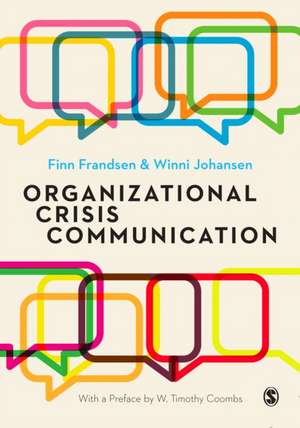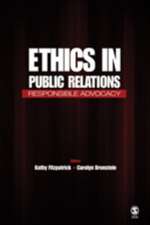Organizational Crisis Communication: A Multivocal Approach
Autor Finn Frandsen, Winni Johansenen Limba Engleză Paperback – noi 2016
This book offers a new and original perspective on crisis communication based on the theory of the Rhetorical Arena and the so-called multivocal approach. According to this approach, we gain a more dynamic and complex understanding of organizational crises if we focus not only on the crisis communication produced by the organization in crisis but also take into account the many other voices who start communicating when a crisis breaks out.
It provides:
- An in-depth overview of the five key dimensions of organizational crises, crisis management and crisis communication
- A comprehensive introduction to the theory of the Rhetorical Arena and the multivocal approach to crisis communication, including some of the most important voices inside the arena
- A series of important international case studies and case examples in each chapter.
| Toate formatele și edițiile | Preț | Express |
|---|---|---|
| Paperback (1) | 480.56 lei 6-8 săpt. | |
| SAGE Publications – noi 2016 | 480.56 lei 6-8 săpt. | |
| Hardback (1) | 1148.93 lei 3-5 săpt. | +25.27 lei 4-10 zile |
| SAGE Publications – noi 2016 | 1148.93 lei 3-5 săpt. | +25.27 lei 4-10 zile |
Preț: 480.56 lei
Preț vechi: 624.11 lei
-23% Nou
91.96€ • 96.33$ • 76.21£
Carte tipărită la comandă
Livrare economică 08-22 aprilie
Specificații
ISBN-10: 1446297063
Pagini: 280
Dimensiuni: 170 x 242 x 17 mm
Greutate: 0.5 kg
Ediția:First Edition
Editura: SAGE Publications
Colecția Sage Publications Ltd
Locul publicării:London, United Kingdom
Recenzii
"Rare are the cases of the 'big idea' that forever alter the intellectual landscape of the field. You are about to read a book by two authors who have lent such a voice in crisis communication."
The importance of this book lies in its new and original perspective on crisis communication, introducing new meanings of the words “arena” and “voices”, which leads to a much deeper understanding of how risk and crisis intertwine. The authors have written each chapter diligently to make the book very useful and interesting for all who want to learn about crisis communication or who face crises on daily basis, and in that respect they made a truly remarkable work.
This is an incredible book and, as reviewers have identified, potentially 'changes the intellectual landscape of the field'. I am an admirer of Frandsen & Johansen's work and in this book they have provided both a historical account of the field of crisis communications from a needed European perspective, and a direction for future research. I shall be recommending this book to students and colleagues.
Cuprins
Foreword by W. Timothy Coombs
General Introduction
PART I: KEY DIMENSIONS OF ORGANIZATIONAL CRISES, CRISIS MANAGEMENT AND CRISIS COMMUNICATION
1: Living in a Crisis Society
2: What Is a Crisis? Definitions and Typologies
3: Crisis Management (I) General Perspectives: From Anticipation to Resilience
4: Crisis Management (II): Staged Approaches: Before, During, and After Crisis
5: Crisis Communication (I): Rhetorical and Text-oriented Approaches
6. Crisis Communication (II): Strategic and Context-oriented Approaches
Chapter 7: The (Inter)Cultural Dimension
PART II: VOICES IN THE ARENA
Chapter 8: The Rhetorical Arena: A New Theoretical Framework
Chapter 9: Consumers and Citizens: Emotions and Social Media
Chapter 10: News Media: Mediatization and Crisis Journalism
Chapter 11: Intermediaries: Trade Associations
Chapter 12: Managers and Employees: Inside the Organization
Epilogue: The Future of Organizational Crisis Communication: Agendas for Research, Education, and Practice
Notă biografică
Finn Frandsen (mag. art., Aarhus University) is Professor of Corporate Communication and Director of Center for Corporate Communication at the Department of Business Communication, Aarhus School of Business and Social Sciences (Aarhus BSS), Aarhus University (Denmark). His research interests include crisis management and crisis communication, environmental communication, public communication, stakeholder theory, and the institutionalization of strategic communication in private and public organizations. Together with Winni Johansen, he is the originator of Rhetorical Arena Theory and the multivocal approach to crisis communication.
His research has been published in international journals, handbooks and encyclopedias, such as Corporate Communications: An International Journal, International Journal of Strategic Communication, Management Communication Quarterly, Public Relations Inquiry, Public Relations Review, Scandinavian Journal of Public Management and The Handbook of Crisis Communication, Encyclopedia of Public Relations, The Routledge Handbook of Strategic Communication, and Handbook of International Crisis Communication Research.
He is regional editor (Europe) of Corporate Communications: An International Journal and member of the advisory board of the European Communication Monitor. He has served as visiting professor at highly ranked universities and business schools in Norway, Sweden, Finland, France, Italy and Senegal. He has also consulted with organizations in the private and public sector.
Descriere
When a crisis breaks out, it’s not always just the organization that reacts - the news media, customers, employees, trade associations, politicians, activist groups, and PR experts may also respond.
This book offers a new and original perspective on crisis communication based on the theory of the Rhetorical Arena and the so-called multivocal approach. According to this approach, we gain a more dynamic and complex understanding of organizational crises if we focus not only on the crisis communication produced by the organization in crisis but also take into account the many other voices who start communicating when a crisis breaks out.
It provides:
- An in-depth overview of the five key dimensions of organizational crises, crisis management and crisis communication
- A comprehensive introduction to the theory of the Rhetorical Arena and the multivocal approach to crisis communication, including some of the most important voices inside the arena
- A series of important international case studies and case examples in each chapter.




















